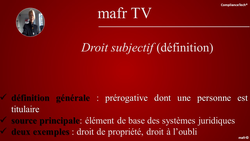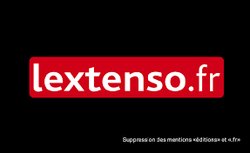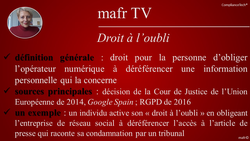The recent news
Jan. 20, 2020
MAFR TV : MAFR TV - definition

Regarder la vidéo définissant le Droit subjectif

Jan. 17, 2020
Publications

This Working Paper written in English is the basis for an article published in French in the French journal Dalloz Avocat , in March 2020.
Summary of the working Paper.
If we perceive Compliance Law as an aggression of the private company and a binding set of mechanisms that have no meaning and added value for it, then the attorney has a utility: defending the business. It can do so not only during the sanctions phase, but also to prevent it.
But this function is not central.
It becomes so if we understand Compliance Law as a body of substantial rules, pursuing a "monumental goal": the protection of the person, goal injected by political bodies and taken up by the operator. From this, the company must convince everyone to take it back, inside the company and outside. In a general and contradictory debate, the attorney carries this conviction, because he and she is always convincing those who at the end judge (market, public opinion, etc.) that is their raison d'être.
(In this short document, the pop-ups refer to the different works that develop each of the points)
Jan. 15, 2020
Interviews

Référence complète : Frison-Roche, M.-A., Haine sur Internet : il faut responsabiliser les opérateurs numériques, entretien avec Olivia Dufour, Actu-juridique Lextenso, 15 janvier 2020.
Les questions posées étaient :
- Pour lutter efficacement contre la haine sur Internet, la proposition Avia demande aux plateformes d'intervenir sous le contrôle du CSA. Ce système, inspiré de l'économie, est-il transposable dans un domaine aussi sensible que la liberté d'expression ?
- Comprenez-vous la crainte du Syndicat de la magistrature que les plateformes ne se transforment en organe de censure ? N'est-ce pas un défaut de conception du texte ?
- Pensez-vous que l'on puisse se passer de la protection du juge judiciaire en matière de liberté d'expression ? Précisément dans cette loi, estimez-vous qu'il a sa juste place ou que celle-ci devrait être renforcée ?
Lire les trois réponses données dans l'interview.
______
Jan. 8, 2020
MAFR TV : MAFR TV - case

Regarder la video qui présente et analyse la décision n°2019-796 du 29 décembre 2019 du Conseil constitutionnel, Loi de finance pour 2020.
Lire l'extrait ici pertinente de cette décision du Conseil constitutionnel.
_____
Pour lutter contre la fraude fiscale, la contrebande et le blanchiment d'argent qui en résulte, le Gouvernement avait souhaité prendre l'information là où elle se trouve, là où chacun a tendance désormais à étaler sa vie privée, et celle des autres : sur les réseaux sociaux.
C'est pourquoi le projet de Loi de finance pour 2020 prévoyait, à titre expérimental (3 ans), de conférer aux administrations fiscales et douanières de pouvoir collecter des données accessibles publiquement sur les plateformes aux fins de rechercher des "manquements et infractions en matière fiscale et douanière".
L'on avait pu s'en inquiéter au regard de la Constitution et notamment du "droit à la vie privée".
Il n'est pas étonnant que lors du contrôle opéré par le Conseil constitutionnel de la Loi de finance votée, l'alléguation d'une violation de la Constitution ait été formulée par les requérants.
Mais c'est le contraire qui arriva.
Tout d'abord, il était soutenu que le Gouvernement avait glissé cette disposition, qui serait attentatoire aux libertés, dans la Loi de finance pour mieux la masquer mais qu'elle est sans rapport, ce qui est contraire à la méthode constitutionnellement requise dans l'art législatif. Le Conseil rejette cette critique car c'est pour lutter contre la fraude fiscale et améliorer le recouvrement de l'impôt que ces informations sont collectées, but financier de l'Etat qui justifie une place dans une Loi de finance.
Substantiellement, s'il est vrai que le Conseil constitutionnel, par sa décision du 29 décembre 2019, Loi de finance pour 2020, déclare la loi contraire à la Constitution, ce n'est que sur une modalité accessoire du dispositif. En effet une disposition spécifique prévoyait la possibilité d'utiliser une majoration de 40% pour défaut ou retard de production de déclaration pour la recherche de manquement, ce qui est disproportionné. Mais cela ne touche en rien l'ensemble du dispositif qui est quant à lui validé dans son principe et dans son organisation technique.
Il est particulièrement important dans l'équilbre que le Conseil pose et les conséquences probatoires qu'il implique.
En effet et à la base, il y a le principe constitutionnel de la liberté d'expression, en ce que celle-ci est à la racine de la Démocratie. Lorsque les internautes postent des informations sur l'espace numérique publique, c'est un acte de cette nature et de cette portée. Ensuite, l'objet ainsi produit, l'information qui les concerne, la "donnée à caractère personnelle", est elle-aussi l'objet d'une protection constitutionnelle. En effet le droit à la vie privée est de valeur constitutionnelle et vient protéger également la personne.
Face à ces deux sources fondamentales, le Législateur et l'Etat qui captent des données sont qualifiés comme "y portant atteinte". Ce n'est pas pour autant qu'ils ne sont pas légitimes à le faire. Mais ils doivent se justifier. C'est avant tout un système probatoire que le Conseil constitutionnel met en place. Tandis que la personne n'a pas à justifier l'usage qu'elle fait de sa liberté (d'expression) et de son droit (sur ses données), le Législateur doit justifier l'atteinte légitime qu'il y porte par un triple test : nécessité, ordre public, modalités adéquates et proportionnées.
I. CONFIRMATION DU NIVEAU CONSTITUTIONNE DU DROIT A LA PROTECTION DES DONNEES A CARACTERE PERSONNEL, S'ANCRANT DANS LA LIBERTÉ D'EXPRESSION, ET CONDITIONS CONSTITUTIONNELLES POUR Y PORTER LEGITIMEMENT ATTEINTE : NÉCESSITÉ, MOTIF D'INTERET GENERAL ET MISE EN OEUVRE ADEQUATE ET PROPORTIONNEE
Le Conseil constitutionnel s'appuie sur l'article 2 de la Déclaration des droits de l'Homme de 1789, lequel vise d'une façon très générale quatre droits dont les personnes sont titulaires et que toute organisation politique vise à protéger : "la liberté, la propriété, la sûreté, et la résistance à l'oppression". De cette "liberté" si généralement visée, la jurisprudence constitutionnelle a tiré de nombreuses libertés plus précises et de nombreux droits.
Ainsi, le Conseil constitutionnel pose que la liberté de communication y est incluse ainsi que le "droit au respect de la vie privée". Par un raisonnement en poupée russe, dans ce droit au respect de la vie privée, le droit à la protection de ses "données personnelles", lui-même inclus dans le "droit au respect de la vie privée" est de valeur constitutionnelle.
En outre le Conseil se référence à l'article 11 de la Déclaration de 1789 qui se référe à la "liberté d'expression" et sa décision insiste spécifiquement sur le lien entre celle-ci et le mécanisme démocratique. Il le fait dans ces termes : " la liberté d'expression et de communication est d'autant plus précieuse que son exercice est une condition de la démocratie et l'une des garanties du respect des autres droits et libertés.". Le Conseil souligne d'une façon pédagogique que si le Parlement a la tâche de veiller à garantir les droits (article 34 de la Constitution), ceux-ci présuppose ce fonctionnement démocratique, lequel dépend de la liberté d'expression.
Ainsi la liberté d'expression est à la racine d'un Etat de Droit. Il faut donc comprendre que l'Etat étant lui-même en charge de veiller au fonctionnement démocratique de la société et devant concrétiser les droits constitutionnels des personnes, il doit respecter ces deux éléments premiers.
L'essentiel du raisonnement, la portée de celui-ci, est dans cette préséance.
Le système est en effet le suivant : le principe est du côté unifié des personnes et de la démocratie (fondant et la protection des données personnelles et la liberté d'expression) qui, sans avoir à se justifier, bénéficient du droit à n'être pas atteintes dans leur droit tout d'abord de communiquer librement sur les divers supports numériques puis de n'être pas dépossédées contre leur consentement de ces informations ("données personnelles"), tandis que le Législateur s'il veut le faire ne peut le faire que s'il peut justifier d'une part d'un motif d'intérêt général et d'autre part de modalités adéquates et proportionnées.
C'est donc une sorte de système probatoire, dans lequel les parties ne sont pas à égalité, système dans lequel c'est la personne qui prévaut : en effet la personne va toujours prévaloir car elle exerce une liberté par laquelle la Démocratie vie (s'exprimer librement), ce qui génère des données sur lesquelles elle a un droit (droit au respect de ses données) ; puisque c'est son droit à valeur constitutionnelle, elle n'a pas à le justifier.
Certes le Législateur peut y porter atteinte, car tout principe supporte des exceptions et aucun droit, même constitutionnel, n'est sans limite. Ainsi si le Législateur peut justifier d'un "motif d'intérêt général", alors il pourrait prétendre avec succès limiter le droit constitutionnel de chacun à la protection de ses données personnelles. Mais s'il parvient à arguer d'un tel motif, cela ne vaudra pas blanc-seing : il faudra que les modalités soient adéquates et proportionnés.
Ici, le Conseil constitutionnel constate que le Législateur a effectivement porté atteinte au droit constitutionnel de toute personne à la protection de ses données personnelles qui, ici, s'ancre dans la liberté d'expression laquelle est le socle de la Démocratie. Le Législateur peut certes le faire mais il ne peut le faire que si cela est nécessaire, si cela est corrélé à un motif d'ordre public et les modalités sont adéquates et proportionnées. Un sorte de triple test....
En ce qui concerne la "nécessité", notion fondamentale pour toute atteinte aux libertés, il est souvent rappelé que le numérique a permis l'accroissement de la criminalité. Il est donc nécessaire que l'on recherche des nouveaux moyens de collecter l'information dans ce nouveau monde où il est si facile d'agir masquer Le Conseil constitutionnel souligne qu'il s'agit de rechercher des actes illicites rendus plus aisés par Internet. La loi vise trois types d'atteinte à l'intérêt public : la fraude fiscale, le blanchiment d'argent et la contrebande. Cela rejoint le "motif d'ordre public", requis.
La troisième condition porte en aval sur les modalités, elle provoquera en partie la chute du législateur. En effet, le dispositif passe le test puisque les administrations fiscales et douanires ne peuvent capter que les informations volontairement mise à disposition de tout public par les internautes, la reconnaissance faciale est une technique exclue et les informations "sensibles" sont retirées de toute exploitation. Les mesures sont donc "proportionnées", nouvelle forme de l'exigence de nécessité, la loi confiant au Réglement la rédaction de texte pour faire en sorte que les algorithmes soient paraphrés pour que ce lien de nécessité demeurent entre l'ampleur de la captation et du traitement et les buts légitimes visés ....
En ce qui concerne les modalités,
II. PORTÉE DE L'ARTICULATION DU PRINCIPE CONSTITUTIONNEL POUR LA PERSONNE DE S'EXPRIMER DANS LE NUMÉRIQUE PUIS DE PROTÉGER SES DONNÉES PERSONNELLES ET DE L'EXCEPTION LÉGITIME DE L'ÉTAT A Y PORTER ATTEINTE
Parce que les deux premiers (principe de la liberté constitutionnelle d'expression, principe du droit constitutionnel de la personne sur les données qui la concernent) s'imposent sans qu'il soit besoin de les justifier, lorsque les textes seront silencieux, ce seront eux qui empliront ce silence.
Lorsque les Autorités ou un coconctractant, ou un Juge - dans son pouvoir de qualification des situations et des actes -, voudront faire prévaloir une autre considération, alors il faudra qu'ils se prévaloir d'un motif d'ordre public.
En effet les principes doivent être "conciilés", comme le dit le Conseil constitutionnel et les droits s'arrêtent là où les droits des autres commencent. Mais c'est à celui qui veut arrêter le principe de la liberté expression, le principe de la libre communication, le droit à la protection des données personnelles, de trouver le motif d'ordre public.
Celui-ci est dans le but : dans le cas présent, il s'agit de la lutte contre la fraude et le blanchiment d'argent.
Comme on le sait, l'interprétation restrictive des textes répressifs n'exclut pas leur interprétattion téléologique.
C'est dans une telle perspective probatoire, tracée par le Conseil constitutionnel, que le système va vocation à s'appliquer d'une façon plus générale.
_____________________

Dec. 31, 2019
Antechronological CV
► read the general presentation of Marie-Anne Frison-Roche
► travel to the future:
► travel to the past:
► go back to the general CV, bringing to several specific thematic CVs :
📜 Civil Law;
📜 Economic Law and Regulatory & Compliance Law ;
📜 Global Law ;
📜 Theory, Sociology & Philosophy of Law
►Academic Titles and diploma (for more details, s. general CV,) :
🎓 Full professor of University, first Class.
🎓 Major (first place) of the Agrégation des Facultés de Droit en droit privé et sciences criminelles (French National recruitment Contest for recrutement of University Professors in Private and Criminal Law), 1991,
🎓 PHD in Law, Paris Panthéon-Assas University, Summa Cum Laude ; thesis published.
🎓 Master in Private Law, Panthéon-Sorbonne University, Cum Laude
🎓 Bachelor in Philosophy, Sorbonne University,
🎓 Master in Procedural Law, Panthéon-Assas University, Summa Cum Laude
Dec. 30, 2019
MAFR TV : MAFR TV - definition
Dec. 27, 2019
Law by Illustrations

La fable de La Fontaine
Un mal qui répand la terreur,
Mal que le Ciel en sa fureur
Inventa pour punir les crimes de la terre,
La Peste (puisqu’il faut l’appeler par son nom),
Capable d’enrichir en un jour l’Achéron,
Faisait aux Animaux la guerre.
Ils ne mouraient pas tous, mais tous étaient frappés :
On n’en voyait point d’occupés
À chercher le soutien d’une mourante vie ;
Nul mets n’excitait leur envie ;
Ni Loups ni Renards n’épiaient
La douce et l’innocente proie ;
Les Tourterelles se fuyaient :
Plus d’amour, partant plus de joie.
Le Lion tint conseil, et dit : « Mes chers amis,
Je crois que le Ciel a permis
Pour nos péchés cette infortune.
Que le plus coupable de nous
Se sacrifie aux traits du céleste courroux ;
Peut-être il obtiendra la guérison commune.
L’histoire nous apprend qu’en de tels accidents
On fait de pareils dévouements.
Ne nous flattons donc point, voyons sans indulgence
L’état de notre conscience.
Pour moi, satisfaisant mes appétits gloutons,
J’ai dévoré force moutons.
Que m’avaient-ils fait ? nulle offense ;
Même il m’est arrivé quelquefois de manger
Le berger.
Je me dévouerai donc, s’il le faut ; mais je pense
Qu’il est bon que chacun s’accuse ainsi que moi ;
Car on doit souhaiter, selon toute justice,
Que le plus coupable périsse.
– Sire, dit le Renard, vous êtes trop bon roi ;
Vos scrupules font voir trop de délicatesse.
Et bien ! manger moutons, canaille, sotte espèce,
Est-ce un péché ? Non, non. Vous leur fîtes, Seigneur,
En les croquant, beaucoup d’honneur ;
Et quant au berger, l’on peut dire
Qu’il était digne de tous maux,
Étant de ces gens-là qui sur les animaux
Se font un chimérique empire. »
Ainsi dit le Renard ; et flatteurs d’applaudir.
On n’osa trop approfondir
Du Tigre, ni de l’Ours, ni des autres puissances,
Les moins pardonnables offenses.
Tous les gens querelleurs, jusqu’aux simples Mâtins,
Au dire de chacun, étaient de petits saints.
L’Âne vint à son tour, et dit : « J’ai souvenance
Qu’en un pré de moines passant,
La faim, l’occasion, l’herbe tendre, et je pense
Quelque diable aussi me poussant,
Je tondis de ce pré la largeur de ma langue ;
Je n’en avais nul droit, puisqu’il faut parler net. »
À ces mots, on cria haro sur le baudet.
Un Loup quelque peu clerc, prouva par sa harangue
Qu’il fallait dévouer ce maudit animal,
Ce pelé, ce galeux, d’où venait tout leur mal.
Sa peccadille fut jugée un cas pendable.
Manger l’herbe d’autrui ! quel crime abominable !
Rien que la mort n’était capable
D’expier son forfait. On le lui fit bien voir.
Selon que vous serez puissant ou misérable,
Les jugements de cour vous rendront blanc ou noir.
Dec. 24, 2019
MAFR TV : MAFR TV - case
